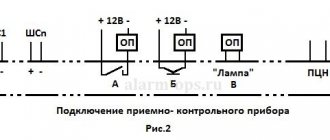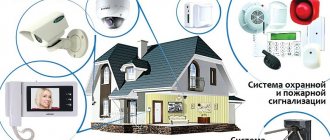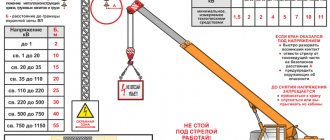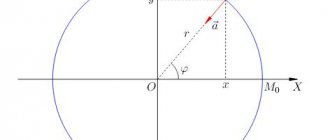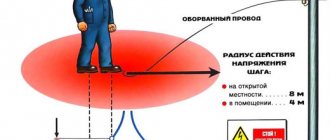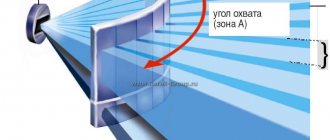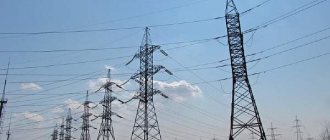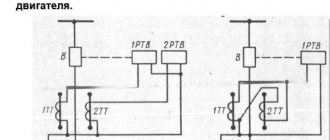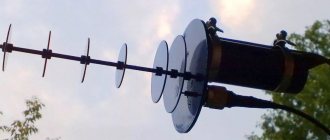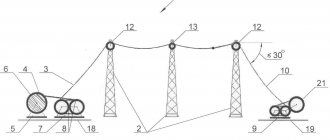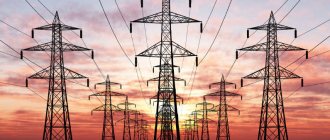Almost all owners of land plots through which overhead high-voltage lines pass are wondering about the restrictions associated with this. We have prepared an information collection that gives an idea of what the power transmission line security zone is and its main purposes. In addition, excerpts from regulatory documents will be given, indicating the burdens for users or owners of areas located along the route of overhead and underground power lines.
What is called the security zone of overhead power lines?
In essence, this is a conditional spatial corridor within which an overhead line (overhead line) is located. The height of the corridor is equal to the length of the power line support, and the width of the security zone is determined by the distance from two vertical projections from the external wires (h in Fig. 1).
Visual representation of the security zone
It is characteristic that the width of the power line zone, when it passes over the water surface, is greater than on land. The dimensions of security zones will be discussed in detail in the section on their boundaries.
Similar sanitary protection zones are provided for other electrical grid facilities, for example, electrical substations and underground power lines (cable power lines).
KLE security zone
Designations:
- H – Depth of the underground electric main.
- L – Distance from the electric main to the edge of the exclusion zone.
Security zone for power lines in populated areas, how to protect yourself from troubles
It is difficult for the owner of a private house to imagine that an ordinary electric pole near a fence or on the property can cause serious trouble.
However, this is true, and the purpose of this article is to help avoid these troubles.
An electric pole, in most cases reinforced concrete, is a support for an overhead power line (power line). And to ensure the safe and trouble-free operation of electric power facilities, security zones are established regardless of land categories.
Restrictions in power transmission line security zones
Thus, problems may arise not because of the pole itself, but because of the security zone and the restrictions associated with it. Therefore, it is important for the landowner to know not only about the prohibitions, but also how to avoid claims from the energy supply organization.
On February 24, 2009, Decree of the Government of the Russian Federation No. 160 approved the rules in accordance with which security zones for power lines are established. These rules establish a list of prohibitions, as well as conditions for the use of land plots within the boundaries of which security zones are located.
For most cases (for networks with voltages up to 1 kV), the size of the security zone on the ground is 2 meters on both sides of the outermost wires. The higher the voltage, the larger the zone: with a voltage from 1 to 10 kV, this is already 10 meters.
Without approval, within the protected zones it is prohibited:
- build buildings and structures (including a garage, bathhouse, barn, etc.), as well as carry out major repairs, reconstruct or demolish them;
- erect structures, including fences (fences), enclosures, hangars, which may impede access to electrical grid facilities;
- place garages and parking lots, plant trees and shrubs, store materials, store fuel and lubricants, etc.
Some argue that these prohibitions do not apply to facilities built before the date of entry into force of the Resolution, i.e. until February 24, 2009, because this is directly stated in the rules themselves. But this is a misconception. Until this date, similar prohibitions established by the 1972 rules of the USSR Council of Ministers were in effect.
Thus, if there is a distance of 2 meters from your fence to a pole with a voltage of 0.6 kV, then there is a risk of serious difficulties.
Consequences of construction in a protected zone without an approval decision
If representatives of the energy company discover obvious violations of the power line security zone, they will draw up a corresponding Report. They do not have the power to fine land owners.
An inspector from the Office of Rostechnadzor, the Federal Service for Environmental, Technological and Nuclear Supervision, has the right to draw up a protocol on an administrative violation. A fine of 500 to 1000 rubles will be imposed only for violating the rules for protecting electrical networks with voltages over 1 kV. And for such “powerful poles” the size of the zone increases to 10 meters from the outermost wires.
Power line security zone
Since the fine and the act do not greatly frighten land owners, power engineers often resort to radical measures. To begin with, the network campaign will demand in writing to dismantle the fence and garage, giving 10 days for this. The owner may also be offered an alternative solution to the issue - at his own expense, move the post away from the fence. Of course, such a “bill” will be very large!
If the intimidation does not have an effect and it is not possible to reach an agreement, the power engineers will go to court with a demand to oblige the owner to dismantle the fence in the security zone and ensure unhindered access to the networks.
Since everyone's situation is individual, courts make different decisions. And as a rule, they are not in favor of ordinary citizens. But there is always a chance!
Purpose of power transmission line security zones
The main goal of introducing such restrictions is to prevent direct and indirect factors of the negative impact of electric current on the human body. The first includes electric shock due to direct contact with an overhead line wire or from step voltage. When a wire breaks, the probability of such consequences is quite high, so an exclusion zone of certain dimensions is established for electric highways.
By indirect factors we mean the harmful effects of a high-tension electric field. Back in the last century, the involvement of electromagnetic radiation in the development of various pathologies in the human body was established. Those who live in the exclusion zone of power lines are more at risk of developing central nervous system dysfunctions, cardiovascular pathologies, disorders of neurohormonal regulation, etc.
As you move away from power lines, the intensity of electric fields in the protection zone decreases, and accordingly, their negative impact decreases.
Diagram of the propagation of electromagnetic radiation near a power line support with a voltage of 330-500 kV
Bottom line
Construction in the protected zone and other work are prohibited conditionally, that is, possible with the consent of the company under whose jurisdiction this infrastructure is located. But there are also strictly prohibited events.
When analyzing information, an interested person must definitely read the regulatory documents we indicated at the beginning of the article, and especially Resolutions 160, 1033, 578, which more specifically provide lists of what is prohibited, what is allowed and in what cases, depending on the parameters of the lines. It should be noted that there are different rules: there are direct prohibitions and conditional ones (work is possible with the consent of the responsible companies), for lines of different power (up to 1000 V and above), for underground, underwater, and air communications.
Classification of protected areas with power lines
The following classification of security corridors has been adopted for the power grid system:
- Alienation of territory along overhead lines laid on land. The principle of differentiation was discussed above (see Fig. 1).
- Territories along underground cable lines (see Fig. 2).
- Alienation of space near underwater cable lines. The corridor is limited by vertical planes, conventionally located at a distance of 100.0 m on both sides of the cable, the water surface is considered the upper limit.
- Security corridors when crossing water power lines. In this case, the width of the corridor depends on whether the section of the water surface is navigable; if so, then the distance from the external cable to the border is 100.0 m. Otherwise, the width is calculated as for land.
- Radius of the security zone of transformer substations. The protective radius is set based on belonging to a certain voltage class; the ceiling is considered to be the highest point of the network facility.
Sanitary norms and rules for human activity and presence in the power line area
According to the rules of SNiP, a certain relationship has been established between the voltage class of power lines and the size of the security zone around the power line. In addition, sanitary rules clearly indicate what distance is considered acceptable between power lines and residential buildings or other economic facilities.
Safe distances are established in accordance with the power of the power line; according to sanitary standards, the permissible voltage level should not exceed 1.0 kV/m. Below is a table with current standards. The dependence of the exclusion zone on the power of the overhead line is clearly shown in the figure.
Safe distance from power lines, depending on the voltage class
In addition to sanitary standards, it is necessary to take into account the requirements of the PUE; it makes sense to consider them in detail.
Security zone distances
Whatever the distance around the supports according to the law (for example, the security zone of a 10 kV power line requires 10 m on each side), the norms for distances from the supports must still be observed. The installation must perform its functions without threatening anyone’s life or health.
Near the power plant
The main document on the placement of power lines, the procedure for their installation and determining how many meters in each direction need to be retreated when creating security zones is Resolution No. 169, adopted on February 24, 2009 “On the procedure for installing security zones.”
This document is the fundamental Government Decree on the development and placement of power lines, the construction of power lines and the creation of proper boundaries - in the official zone, for which a special legal definition has been developed.
The location of switchgears and points, transformer substations according to regulations is carried out in special buildings and structures that are constantly closed. Departmental instructions provide for the procedure for access of specialists with clearance and authority, and also prohibit access by outsiders.
Diagram of sanitary zones for power lines in accordance with SanPiN standards
It is impossible to build special premises for hundreds of kilometers of overhead power lines, and they are cheaper than laying underground cables, although they remain accessible not only to those who are legally responsible for their condition and operation.
Responsibility for the correct use of power lines rests with those involved in electrical networks.
They are responsible not only for repairs and security, but also for limiting the security zone of power lines. Their responsibilities also include informing the public about the degree of danger and standards for preventing possible consequences.
Supports near the village
Security measures are as follows:
- In determining how many meters is the minimum distance from a power line to a residential building, industrial building, public or domestic building. Reducing it is prohibited by law, and a violation of the prohibition is subject to administrative sanctions under the Code of Administrative Offences.
- Allocation of a plot of land of a certain size in the security zone of a power transmission line, along a vertical plane from the wires. Approaching the earth boundary can be permitted or prohibited only if it is set depending on the number of volts in the overhead line (OHL).
- When structures with wires are located on the water surface, the determination of the permissible distance is also the minimum distance determined by the operating rules.
- When located underground or underwater, it carries out a designation that depends not only on the voltage, but also on the navigability or non-navigability of the reservoir.
- Special clearings are being cut down in forests, shelterbelts and parks. In this case, cutting down each tree carries additional measures to ensure fire safety in the power transmission line security zone and prevent environmental vandalism in the event of a fire.
Table of norms, how many meters you need to retreat in each direction
The work of organizations responsible for safe production or living in places where power lines pass includes the need to place warning signs. Each of them should be durable and bright, reaching a size of 28x21 cm, in case someone has poor eyesight.
PUE requirements
The 7th edition (R. 2, Chapter 2.5) specifies the following standards:
- If a 0.4 kV - 1 kV overhead line is located parallel to the gas pipeline, then the distance between them must exceed the height of the electrical support. In cases where the pipelines intersect, an ungrounded protective canopy (screen) is installed over the gas pipeline, protecting the pipeline in the event of a power line break. The width of the screen should extend beyond the projection of the external power line by a distance depending on the voltage class:
- For overhead lines 20.0 kV - 3.0 meters.
- Overhead line 35.0 kV – 110.0 kV – 4.0 m.
- 150.0 kV – 4.50 m.
- 220.0 kV – 5.0 m.
- 330.0 kV – 6.0 m.
- 500 kV – 6.50 m.
- Since power lines can pass over certain types of non-residential buildings (workshops, warehouses, etc.), the distance between them and external overhead lines is considered safe in the following cases:
- 20.0 kV – at least 2 meters.
- 35.0-110.0 kV – from 4 m.
- 150.0 kV > 5.0 m.
- 220.0 kV and more – 6.0 m.
At the same time, there are restrictions according to which the construction of schools, kindergartens, sports grounds, and other facilities with large numbers of people is prohibited in the exclusion zones.
- Power lines are prohibited from running over residential buildings, the only exception being input lines.
- Between the power line and a parallel road, a distance of at least X+5 m is allowed, where X is the height of the electrical support. In cases where the lines cross a road belonging to the 1st category, the installation of anchor supports is required.
- If electric mains pass near technological facilities where explosive or flammable substances are stored or used (for example, gas stations), then the permissible distance is determined by one and a half height of the electric support.
- The height of the power line from the ground is determined by the voltage class of the latter and the type of terrain; the permissible distances are given below.
Permissible distances from wires to ground
Please note that in populated areas, the permissible distance from wires to ground has been increased. Detailed information about this can be found in the latest edition of the PUE.
What activities are prohibited?
In the exclusion zone, it is unacceptable to carry out actions that could disrupt the safe functioning of the network and cause the creation of emergency situations of varying degrees of complexity. These actions include:
- Throwing foreign objects onto overhead lines, as well as placing them on poles and supports of electrical networks.
- Erect buildings that block access to substations, poles or other electrical network facilities, or clutter the passage and access routes with various objects.
- Launch flying kites, drones or other aircraft.
- Enter inside the fenced area and power grid buildings (transformer or distribution substations, etc.).
- Make fires in the security zones of overhead lines, underground power lines or other electrical facilities.
Short circuit to ground due to a fire built under a power line. - Organize waste sites or landfills in exclusion zones, drain fuel and lubricants or caustic substances, and dump high-tonnage cargo.
- Use a trawl or drop an anchor near the underwater ELC.
- Passage of water transport with a deck superstructure or other mechanism exceeding the permissible size, etc.
It is prohibited to arrange a landfill in the security zone of power lines
With whom and how to coordinate work
The interaction with enterprises in whose jurisdiction the communication lines are located, obtaining permits and coordinating work is reflected in detail in Resolution No. 578. For power lines, such a document is Resolution No. 160. The general rules are contained in other documents indicated by us at the beginning of the article.
In all cases, during planned line maintenance work, the owner of the site is warned in writing by the responsible enterprise.
Coordination for work in communication line areas
The parameters of areas where work and tree planting are prohibited are determined by operating organizations. The boundaries and location of communication lines are created by them and agreed upon with local government (administrations) according to previously drawn up projects.
If there are security zones on plots allocated for agriculture, vegetable gardens, orchards, a note is made in the documents for such lands about the presence of segments with a special regime. The allocation of such plots is carried out by local governments in agreement with the companies operating the lines, which also inform the owner of the plot in writing about the described feature, and also determine the compensation associated with this.
For work carried out by the owner (user) of the site, the written consent of the enterprise responsible for the lines must be obtained (R. III post. N 160). Moreover, such a document must also be obtained from special supervision and control authorities for measures to identify the location of underground communications.
A developer intending to work in the zone no later than 3 days in advance. (working days) before the start of the event, he is obliged to call the responsible employee of the service company to accurately determine the location of the cables. Based on the results of the analysis, a report is drawn up. The line is marked with poles and signs. Workers are familiarized with the hazard data and the information received. Developers notify the responsible company about the start of activities no later than 3 days in advance. Work is prohibited until a representative arrives at the site.
The enterprise is obliged to compensate land owners for losses associated with the maintenance of communication lines and power lines.
Coordination of work in security zones of power lines
To approve work in the security zone of an overhead line or another type (underground, underwater), interested parties submit an application to the network organization no later than 15 working days. days The latter is obliged to consider the application within two days and make a decision on approval. The application must be accompanied by a project, technical documentation (mandatory for blasting activities) and a description of the work.
Obtaining permission to carry out work
Here is a list of works for which it is necessary to obtain written permission to allow them to be carried out in the safety corridor:
- Carrying out any construction work.
- Changing the landscape, flooding, land reclamation or other terraformations.
- Felling forests, cutting down bushes or individual trees, including fruit trees, as well as planting them.
- Carrying out excavation work to a depth exceeding 30 cm or 45 cm on plowed soil (near underground cable lines).
- Dredging the bottom of reservoirs and fishing, including industrial fishing (in the protected zone of the underwater CLE).
- Passage of water transport if the distance between the power lines and the ship (at the highest point) is less than the permissible norm. In this case, it is necessary to take into account the load on the vessel, as well as the current water level.
- Passage of motor vehicles and special vehicles or transportation of oversized cargo under overhead lines, if the distance from the roadway to the highest point of the vehicle exceeds the established limits (usually 4.50 m).
If the vehicle height is more than 4.5 m, passage under power lines must be approved
How is the use of areas falling within the power transmission line protection zone limited?
Land plots located in security zones of power lines are not confiscated from owners, owners or users, but must be used taking into account the restrictions provided for by the Rules for the establishment of security zones of power lines.
The establishment of security zones does not entail a ban on transactions with land plots located in the security zones . Restrictions must be indicated in documents that certify the rights of owners, owners or users of land plots.
In the security zone of power lines, any actions that may disrupt the safe operation of power grid facilities are prohibited, including leading to their damage or destruction, and (or) causing harm to the life, health of citizens and property of individuals or legal entities.
Prohibited:
- throwing foreign objects onto wires and supports of overhead power lines, as well as lifting onto supports of overhead power lines;
- placement of any objects and items within the passages and entrances created in accordance with the requirements of regulatory and technical documents for access to electrical grid facilities;
- carrying out any work and erecting structures that may impede access to power grid facilities, without creating the passages and entrances necessary for such access;
- being within a fenced area and in the premises of switchgears and substations;
- lighting a fire within the security zones of input and distribution devices, substations, overhead power lines, as well as in the security zones of cable power lines;
- placement of landfills;
- carrying out work using impact mechanisms in the security zone of power lines;
- dumping weights weighing over 5 tons, dumping and draining caustic and corrosive substances and fuels and lubricants.
In the power transmission line security zone, without written approval, it is prohibited:
- build, reconstruct, carry out major repairs, demolish buildings and structures;
- carry out mining and blasting operations;
- plant and cut down trees and shrubs;
- carry out loading and unloading operations;
- catch fish;
- vehicles and mechanisms that have a total height with or without load from the road surface of more than 4.5 meters are not allowed to pass (in the security zones of overhead power lines);
- carry out excavation work at a depth of more than 0.3 meters;
- water crops if the flow height is above 3 meters;
- carry out field agricultural work using agricultural machines and equipment with a height of more than 4 meters.
Also prohibited:
- organization of a landfill for garbage and waste;
- treating crops with fertilizers and insecticides containing chemical components that destroy poles or cables;
- presence of people and animals for a long time.
If you are preparing a package of documents for a land plot that is located next to a power line, you need to contact the organization responsible for servicing power lines in the region.
You also need to pay special attention to cable power lines located underground. Before carrying out excavation work, it is necessary to clarify the route of the cable lines. This information can be obtained from the energy supply organization.
It is not allowed to pass power lines through the territories of children's and educational institutions, as well as stadiums. As a rule, passing lines over structures and buildings is prohibited. The exception is production buildings of industrial enterprises 1-2 st. fire resistance.
Rules for staying in the security zone of power lines
The farther the power line is located, the less harm to health . Therefore, you should spend less time in the security zone. Do not approach bare wires lying on the ground. They may be live.
If you approach the wire at a distance closer than 8 meters, you can get an electric shock due to the “step voltage”.
Step voltage is directly related to the voltage class (magnitude) and resistivity of the material . When you see a wire lying on the ground, go around it and approach no more than 20 m.
Numerous factors influence the coverage area, along with the level of exposure to a person.
The largest radius of damage to step voltage is considered to be 8 meters, with dangerous voltage at the break point exceeding 1000 V and 5 m with a value of up to 1000 V.
To quickly exit the danger zone, you should not run or take long steps. It is better to “use a goose step”, without lifting your legs apart from each other. Touching objects and people in the current flow zone is strictly prohibited.
If you can see a very sagging exposed cable nearby, you should not approach it . If a power line is damaged, you should avoid it. Overhead power lines with broken wires are also dangerous.
If a live wire falls onto the ground or onto a current-carrying surface, fault currents begin to flow across the surface.
Violation of the requirements of the “Rules for the protection of electrical networks with voltages over 1000 V”, if it caused an interruption in the supply of electricity, may entail administrative liability:
- individuals are punished with a fine in the amount of 5 to 10 times the minimum wage;
- legal entities are punishable by a fine of 100 to 200 minimum wages.
Establishing the boundaries of the power transmission line security zone, as well as construction
In order to get ahead of the boundaries of the power line security zone, the network organization that owns the power line must apply to Rostechnadzor to obtain a permit.
The application is reviewed within 15 days, and based on the results, a conclusion is made on approval/refusal of approval.
If the answer is positive, the network organization sends documents to Rosreestr within 3 months in order to register the data of the boundaries of the power line security zone.
To build a residential building or other capital construction project, you must apply for permission from the local administration. Who gives permission? The Department of Architecture deals with such issues.
However, the construction will first have to be coordinated with representatives of organizations whose communications are located within the security zone.
What can be built in the power transmission line protection zone? As a general rule, almost any construction within the boundaries of these lands is prohibited. Even the construction of a permanent fence is considered a violation.
Unauthorized buildings will be required to be demolished at your own expense and a large fine will be imposed. And an attempt to legalize self-construction through the court is associated with additional expenses and the risk of refusal.
Construction approval:
- Preparation of documents, filling out an application.
- The petition is sent personally or by registered mail to the company that is in charge of specific communications.
- The response is given within two days from the date of receipt of the documents.
Based on the results of consideration of the appeal, a reasoned decision is made . If a network organization refuses to approve construction, it must voice the reasons and legal provisions confirming the legality of such a refusal.
Otherwise, the refusal should be appealed in court. If a positive decision is made, it is necessary to proceed to the next stage of obtaining a permit.
Obtaining permission to build in a protected zone
If you have documents for the site and a positive response from the organization, you need to contact the administration. Here a building permit is issued in a protected zone.
In addition to the application, the following must be submitted:
- certificate of ownership of the territory;
- if a tenant applies, a lease agreement will be required;
- owner's consent to carry out construction work;
- results of approval of the placement of real estate in the security zone;
- documents for the applicant (identity card, extract from the register of legal entities, etc.).
How to reduce the security zone of power lines? These operations will not be allowed to be performed without authorization; you must act only with the permission of the organization in charge of the overhead power line.
What is a protection zone for overhead power lines? This is a zone along overhead lines in the form of a land plot and air space, limited by vertical planes located on both sides of the line from the outer wires when they are not disconnected at a distance.
In addition to respecting its borders, citizens and organizations do not have the right to carry out certain types of activities in the protected zone. The owner of a land plot is strictly prohibited from carrying out any excavation work on his territory if it is included in the power transmission line security zone.
At the same time, the owner of a land plot falling within the protection zone has the right to use it for growing crops.
A power transmission line security zone is created for any power grid facility . When establishing it, it is necessary to be guided by the requirements for boundaries established by regulations.
